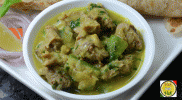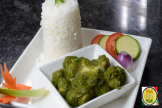Beetroot and spinach is a simple and delicious dish popularly made in the South Indian cu...
Pickled shrimp is a wonderful staple Southern cuisine recipe. It can be had with naan, r...
Paneer Butter Masala is a delicious dish in which succulent cubes of Indian Cottage Chees...

Paneer Pepper Butter Masala is a popular north Indian dish. Paneer added to a spicy, col...

Mutton and ridge gourd curry is an excellent meat preparation with mutton cooked in ridge...

Chana soya masala saag is an interesting dish made with saag masala which has a very good...
A typical Maharashtrian dish also is known as Aloo Arbi Pathe ka Amti made with the leaves of arbi plant and spices.
Aloo ka Path is a typical Maharashtrian dish also known as Aloo Arbi Pathe ka Amti made with the leaves of arbi plant and spices. This is an incredible dish of Taro root leaves cooked in Maharashtrian style. ... Read More..
|
About Recipe
|
|||||||||||||||||||||||||||||||||||||||||||||||||||||||||||||
|
|||||||||||||||||||||||||||||||||||||||||||||||||||||||||||||
Aloo ka Path is a typical Maharashtrian dish also known as Aloo Arbi Pathe ka Amti made with the leaves of arbi plant and spices. This is an incredible dish of Taro root leaves cooked in Maharashtrian style. In this recipe, the taro root leaves are finely chopped and cooked in an array of ingredients and amazing aromatic Indian spices. Aloo ka path is an excellent curry united with an assortment of flavours releasing from a variety of ingredients such as bitterness from fenugreek seeds, spiciness from red chilli powder, green chillies and goda masala, tanginess from tamarind sauce and sweetness from jaggery.

It’s a thrilling and delectable thick saucy curry that goes very well with roti, bhakri, jowar ki bhakri, chapatti or rice. A medley of flavours that would be a delight to your taste buds, refreshing and stimulating to the palate. Arbi or Arvi leaves are large sized, green in colour; heart shaped and is commonly used in Indian dishes. There are many varieties of Colocassia around the world such as eddo, dasheen or elephant’s ear. Taro has a global culinary presence though. Over 10% of the world's population uses it as food staple. Taro leaves offer a substantial amount of Vitamin A and C and are rich in vitamins and minerals.
They are better source of protein than the plant's roots. Raw taro leaves are toxic; however the toxin can be reduced by cooking or soaking overnight in cold water. Taro leaves are popularly used in pacific island cuisines, these leaves are often eaten steamed or as a wrapper for other foods. It's a perennial plant native to Southeast Asia. It is primarily grown as a root vegetable for its starchy corms (aka, taro root) as well as for its leaves. The leaves are a good source of vitamins A and C, contains more proteins and are high in iron than the corms. Arvi leaves are used in making varieties of curries.
The fresh taro leaves are generally rolled into spirals stuffed with a spiced chickpea paste, steamed and fried to make patra or Aloo vadi or Arvi patte ke roll which is a well known Gujarati snack. Arbi or Taro is widely used in south Indian cuisine. There are a variety of dishes that can be prepared with Arbi such as arbi-chamagadda-pulusu, arbi vadai, Stinky delight arbi (taro root) & shrimp vadai, arvi-gosht, arbi-fry etc. Cooked or fried arbi is crispy, has a light mealy texture and a slightly sweet flavour.
The mix of peanuts, cashew nuts, small pieces of radish and channa dal enhances the taste and gives a wonderful crispiness and nutty flavour to this dish. Peanuts in whole, powdered or ground form is widely used in Maharashtrian style of cooking. Peanuts can be used, toasted or steamed. They are very versatile and can be added to savory and sweet dishes. There are used in making a variety of sweets, chocolates, muffins, candies, peanut butter and so on. Boiled peanuts are best accompanied with cocktails and mocktails. They are vital ingredients for making variety of chutneys.
For preparing with appetizing and yummy Aloo Ka Path dish, firstly heat oil in a hot pan and when the oil gets hot, add mustard seeds. When mustard seeds start crackling, add cumin seeds, fenugreek seeds, curry leaves, green chillies, turmeric, hing, red chilli powder, goda masala and sauté the spices.
Immediately add peanuts (soaked in hot water for few minutes), channa dal (soaked in water for few hours), cashew nuts, coconut pieces, radish, chopped arbi leaves and salt to taste. Stir all the ingredients well and put it on a slow flame, cover the pan with a lid and cook for about 4-5 minutes. After 5 minutes of slow cooking, remove the lid and add little water, cover and cook for another 5 minutes.
Remove the lid and check if the arbi leaves are soft and tender. Add jaggery and mix well. Take a teaspoon of besan flour in a bowl, add little water and mix well. Add little tamarind juice and besan flour paste and bring to boil. (the besan flour paste will slightly thicken the gravy).
Sprinkle some roasted peanut powder and mix well and switch off the flame. Serve with hot steamed rice, roti or bhakri. Tip- Wash and pat dry the Colocassia leaves remove the stems and chop finely as desired - thickly or thinly. While preparing this dish, look for light and bright green leaves which are fresh and not limp.
Taro leaves as well as yellow-fleshed roots have significant levels of phenolic flavonoid pigment antioxidants such as ß-carotenes, and cryptoxanthin along with vitamin A. Consumption of natural foods rich in flavonoids helps to protect from lung and oral cavity cancers. It also contains good levels of some of valuable B-complex group of vitamins such as pyridoxine (vitamin B-6), folates, riboflavin, pantothenic acid, and thiamin. It is an excellent source of vitamins C and E, potassium, magnesium, and folate and has good fibre content.
Do try this extraordinary dish. Click on the link below to view the making of this recipe: https://www.vahrehvah.com/aloo-ka-path
Enjoy Cooking!

Jack Ainsworth Posted on Sun Sep 16 2012
do more videos where you can get the igredients also in other parts of the world please
Reply 0 - Replies

rehmaninc Posted on Fri Sep 21 2012
sangeetha u r wrong it is 21 ingredients u totally forgotten two main ingredients of chef Thuma those are Love & Affection .
Reply 0 - Replies
Raj R Posted on Sat Dec 08 2012
Hello, you forgot to mention how to cook taro leaves properly, U need to mention that uncooked taro leaves can be poison!! please check online if you have any doubts
Reply 0 - Replies
Jasmina Khedkar Posted on Thu Mar 24 2016
hi Chef, just one improvisation. instead of adding besan with water, you can use just a little quantity of butter milk and besan. in place of water, replace it with butter milk...the colour, flavour everything turns out to be...very very authentic..?
Reply 0 - Replies Easy recipes
Easy recipes
 Healthy Recipes
Healthy Recipes
 Dessert Recipes
Dessert Recipes
 Mutton and Lamb
Mutton and Lamb  Indian Bread Recipes
Indian Bread Recipes
 Dal Recipes
Dal Recipes
 Chutney and Pickles
Chutney and Pickles  Indo-Chinese Recipes
Indo-Chinese Recipes
 Snacks and Appetizers
Snacks and Appetizers
 Low Fat Recipes
Low Fat Recipes
 Chaat Recipes
Chaat Recipes
 Biryani and Rice
Biryani and Rice  Curry Recipes
Curry Recipes
 Indian Sweet Recipes
Indian Sweet Recipes
 Egg Recipes
Egg Recipes
 Paneer Recipes
Paneer Recipes
 Chicken Recipes
Chicken Recipes
 Indian tiffins
Indian tiffins
 Egg less Recipes
Egg less Recipes
 Soups and Salads
Soups and Salads
 Indian Sea Food
Indian Sea Food
 Manchurian Recipes
Manchurian Recipes
 Indian Drinks Recipes
Indian Drinks Recipes
 Dinner Recipes
Dinner Recipes
hulkimodo Posted on Sat Sep 15 2012
love your videos
Reply 0 - Replies